This section contains entries about our botanizing in Baja California written for the UC BEE (Oct 2012 to Aug 2021)
and The UC Hive (2022-), monthly newsletters for volunteers and staff of the UC Berkeley Botanical Garden.
Click on any photo for a larger image.
BEE AUG 2020
Homeward Bound — May 2020
With Covid-19 restrictions starting to loosen for travel, and conditions improving a bit in California, we decided to head back to the Bay Area in mid May. It was going to be a fast trip so that we could avoid as much contact as possible with other people along the road. We also decided that we would take the route through San Felipe again, as it was shorter, with less traffic, and we would be much more likely to encounter fewer people.
Km 67 S of San Ignacio - Desert Scrub

The scrub on this volcanic hillside was showing signs of spring blooms.
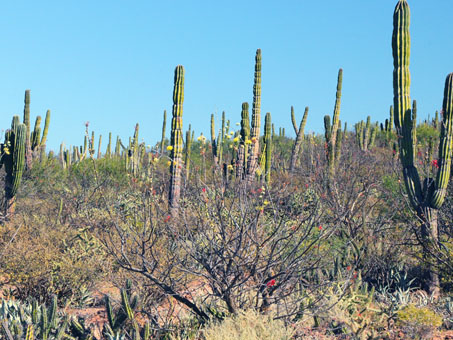
San Francisco Agave/Maguey (Agave cerulata subsp. subcerulata) and Palo Adán (Fouquieria diguetii) are the plants mostly in bloom.

This particular area is dense with succulent species: Barrel cactus, Galloping cactus (Pitahaya agria), Organpipe cactus (Pitahaya dulce), Pincushion cactus, Cardón, Hedgehog cactus, and two chollas (Chainlink and Long-spine cholla).

Other spiny species aren´t lacking: the peninsular endemic Bryant Bur-Sage/Chicura (Ambrosia bryantii, Asteraceae) was in bloom. The staminate flowers are borne in a spikelike inflorescscence; the bell-shaped involucres are drooping. The pistillate flower is a bur with 5 long silvery spines.
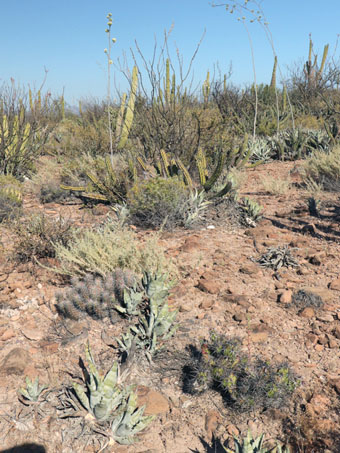
Another endemic cactus species is Casa Rata (Grusonia invicta) seen in the foreground, right.
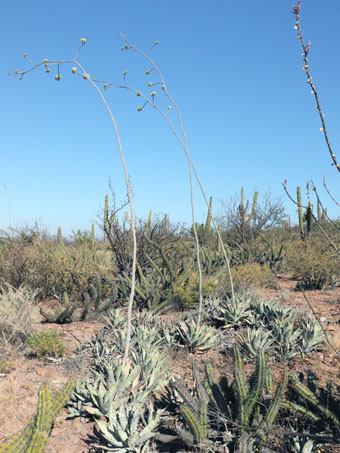
San Francisco Agave/Maguey Agave cerulata subsp. subcerulata) is a BCS endemic.
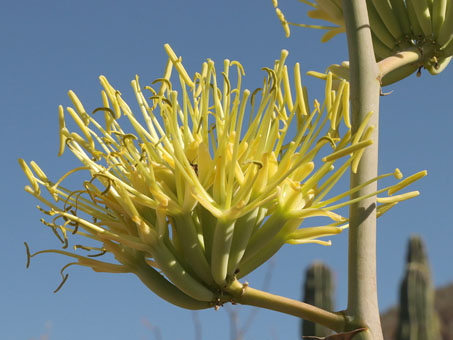
Inflorescence of San Francisco Agave (Agave cerulata subsp. subcerulata). It is easily 3 meters tall.
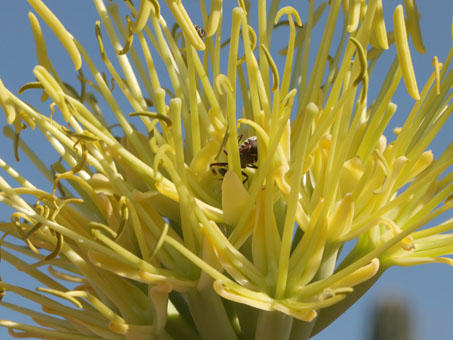
Close up of the flowers of San Francisco Agave. Typical of Agaves are the six tepals. The flower is c. 2.5-3 cm L x D.
Guerrero Negro
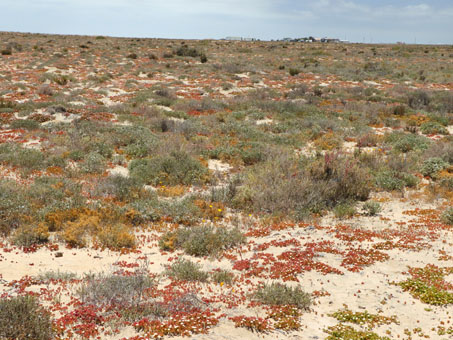
Vizcaíno desert near Guerrero Negro. The rusty red ground cover is non-native Crystalline & Slenderleaf Iceplants. The orange is Dodder. Most of the low, gray-green shrubs are Palmer Frankenia/Yerba Reuma (Frankenia palmeri).
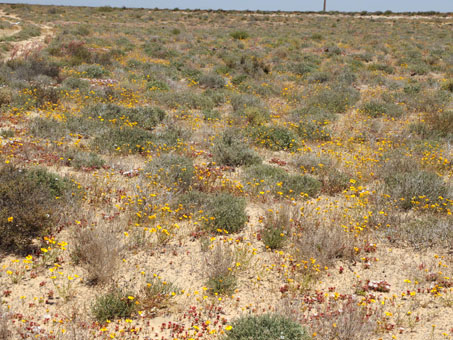
The yellow flowers are Peninsular Dyssodia/Hediondilla (Boeberastrum anthemidifolia, Asteraceae).
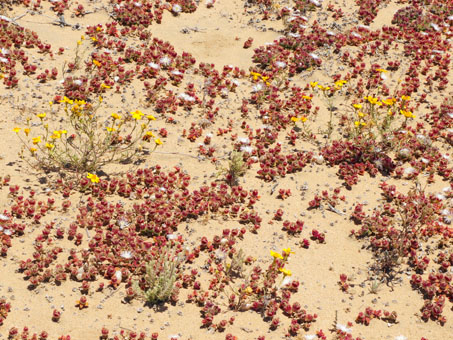
Crystalline Iceplant/Vidriera (Mesembryanthemum crystallinum) with Hediondilla.
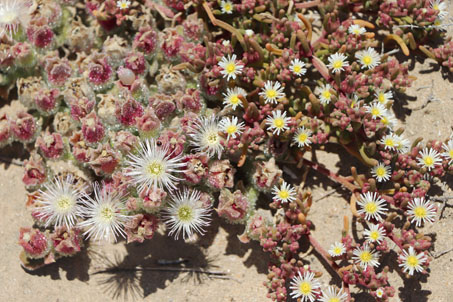
Crystalline Iceplant/Vidriera (Mesembryanthemum crystallinum) on left with flowers about 2 cm D. Slenderleaf Iceplant (M. nodiflorum) on right, the flowers about 1 cm D with distinctly yellow centers. What look like petals are actually petaloid staminodes.
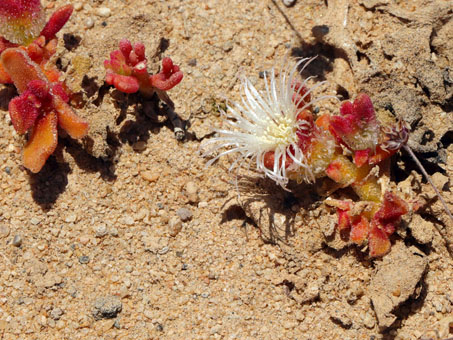
Doesn´t require much plant to have flowers! This iceplant individual is just about 1.5 cm D and 3-4 cm H. Crystalline iceplant has ovate to spatulate leaves, usually with undulate margins.
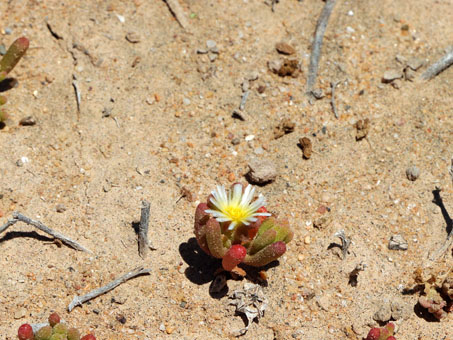
Even smaller, but with more leaves, this Slenderleaf iceplant is about 2 cm D x 2 cm H. The flower is 1 cm D. Slender iceplant leaves are almost terete (round in cross-section) and cylindrical.
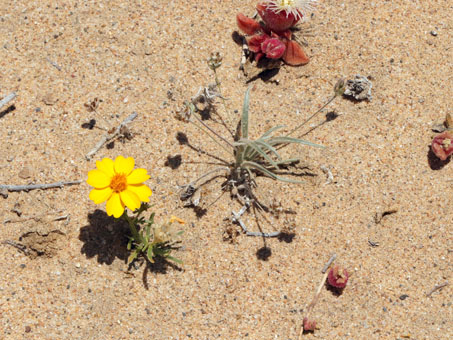
A miniature garden, all under 5 cm H x D: Peninsular Dyssodia, Pacific Plantain (Plantago ovata), and Crystalline iceplant.

A larger specimen of Hediondilla (Boeberastrum anthemidifolia), here about 20 cm H. The Wooly Plantain to the upper right is about 10-15 cm H. The Crystalline iceplant flowers in the foreground will soon unfurl now that the morning sun has broken through the fog.

Vizcaíno Liveforever (Dudleya acuminata). Mostly Slender iceplant in the foreground.
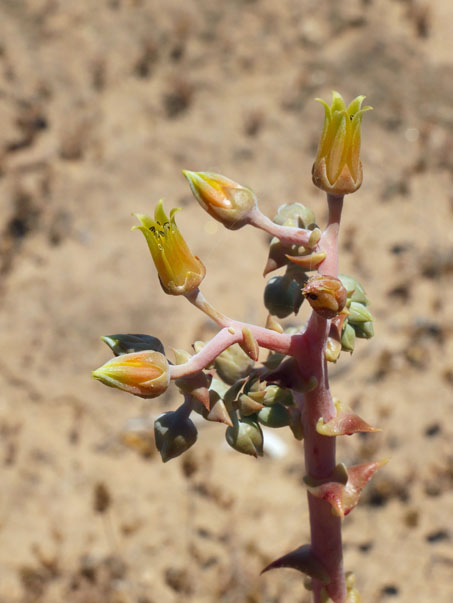
Vizcaíno Liveforever (Dudleya acuminata) corollas are greenish yellow with some red tinge at the base an in the sepals.
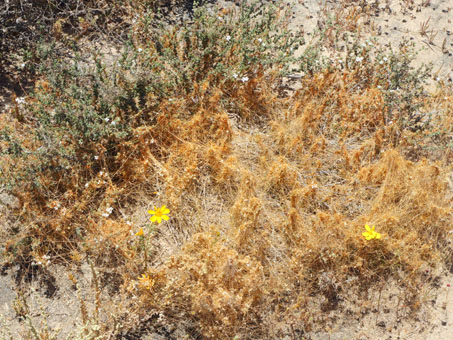
Dodder (Cuscuta sp., Convolvulaceae) draped over a number of small annuals, including Hediondilla and Pineapple-weed (Amblyopappus pusillus, Asteraceae), as well as the shrubby Yerba Reuma.

Vizcaíno Pincushion (Chaenactis lacera, Asteraceae), an endemic annual common in the Vizcaíno Desert. The foliage is fleshy. The capitulum is c. 1.5 cm D.
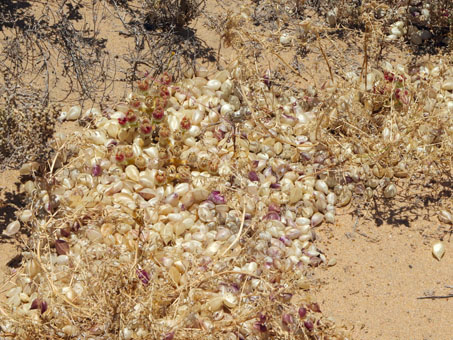
Papery capsules of what appears to be the BC endemic Dune Milkvetch (Astragalus magdalenae var. magdalenae) have been blown into the shelter of a depression behind a small shrub.
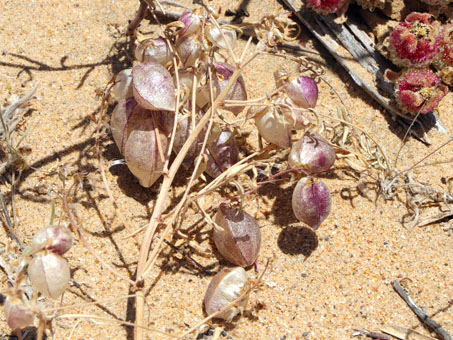
Dune Milkvetch capsules still attached to the dried plant.
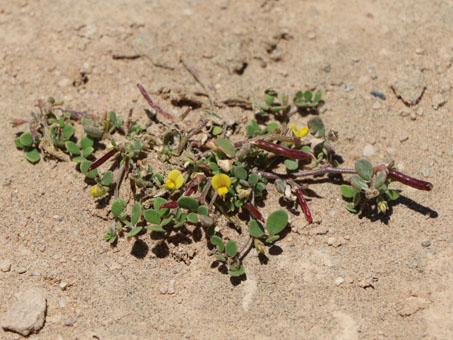
A small Lotus (possibly Acmispon maritimus var. brevivexillus, a native annual). Flowers are c. 5 mm & the entire plant is about 10 cm D. Some plants had stems reaching to about 50 cm D.
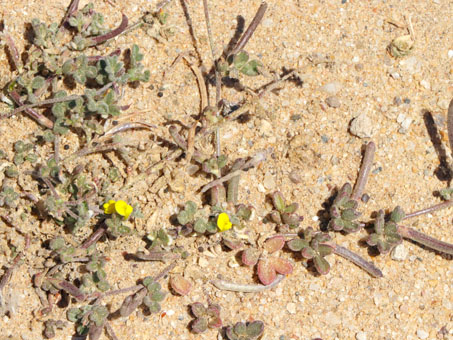
A different Lotus plant (Acmispon sp.). The leaves are quite fleshy and hairy compared to the sample on the left. The leaflets are also differently arranged. Still need to key the specimen collected.
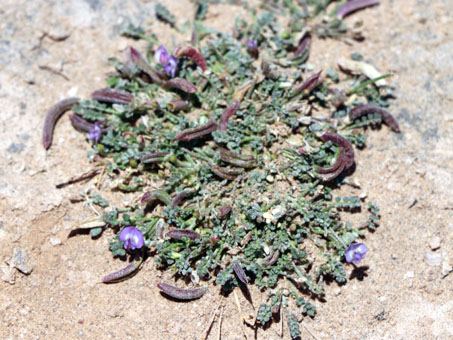
Scammon or Cedros Milkvetch (Astragalus nuttalianus var. cedrosensis, Fabaceae), a native that occurs in nw Mexico and the US southwest. Overall size here is similar to the Lotus plants above.
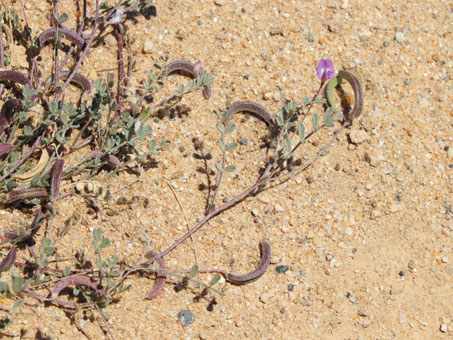
The fruit is arcuate and one of the sutures of the pod has a "channel" running the entire length (inflexed), so that in cross-section it is U-shaped. The gestalt of the plant is similar to Lotus, but the fruit says no.
Vizcaíno Desert —Km 85 N of Guerrero Negro/Villa Jesús María
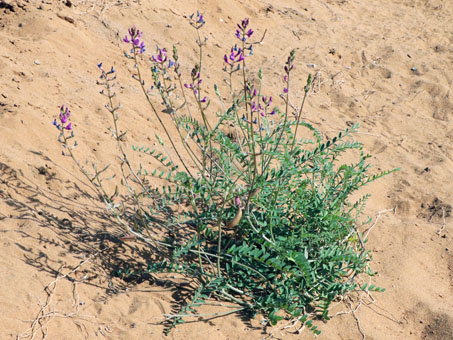
Another Milkvetch, this with fruit characteristics of Astragalus fastidius, an endemic species common along the Pacific coast from around San Quintín to the vicinity of Guerrero Negro.
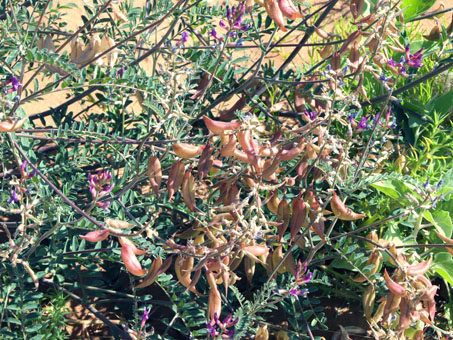
Closeup of another plant of the Milkvetch at left.
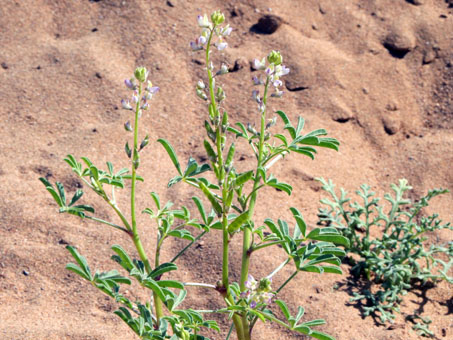
A very pale, unknown Lupinus sp.
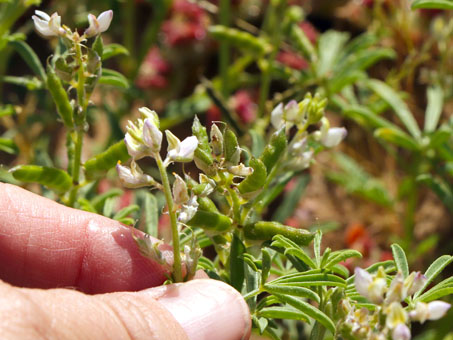
The same unknown Lupinus.
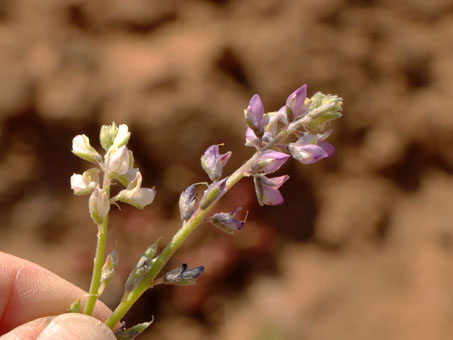
Unknown Lupinus on left, Lupinus sparsiflorus (a common and widespread desert native ranging northward into southern CA) on right.
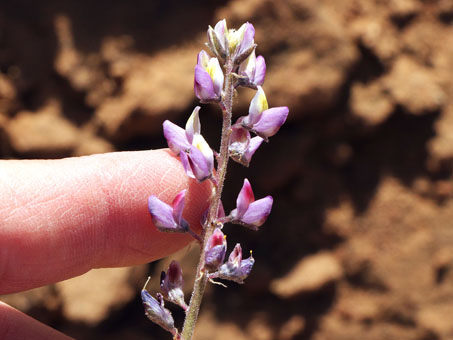
Most noticeable to me was that the banner of Coulter or Desert Lupine (Lupinus sparsiflorus) often turns red or orangish, making it quite distinctive from the other Lupines in the area.
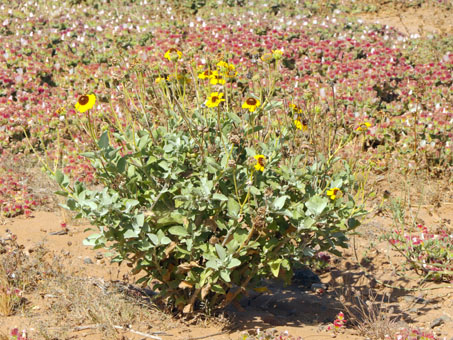
Probably Encelia palmeri (Lots of hybridization occurs in this region mainly between this species and E. ventorum).
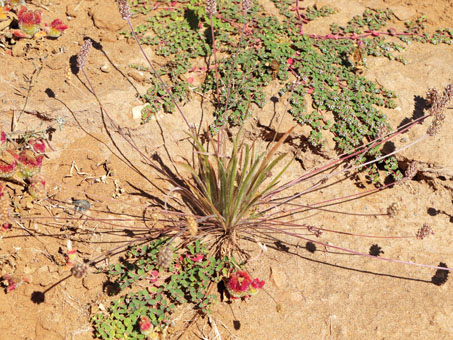
Wooly Plantain (Plantago ovata) and a Sandmat (Euphorbia sp.).
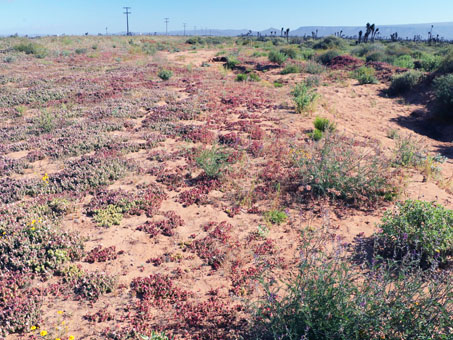
When we were traveling past here in January, the iceplant and other roadside annuals were just sprouts. Now, 4 months later, those sprouts were full-sized with most in bloom or even with fruit.

Ladybird beetle on a Lupine.
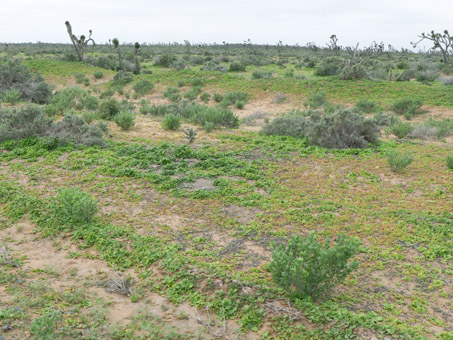
Photo from January of the Vizcaíno Desert just north of Villa Jesús María. The dense green ground cover is Crystalline Iceplant.

Different view at the same location, now in mid May. Here, the Crystalline Iceplant is now mostly without leaves and the purplish to rust red calyces are prominent at ground level.
That's it for this month. Next month, I have the last photos of the season for you, from the trip through the Central and San Felipe deserts on the way to the US border. Until then, hasta pronto...
Debra Valov—Curatorial Volunteer
References
Rebman, J. P., J. Gibson, and K. Rich, 2016. Annotated checklist of the vascular plants of Baja California, Mexico. Proceedings of the San Diego Society of Natural History, No. 45, 15 November 2016. San Diego Natural History Museum, San Diego, CA. Full text available online.
Rebman, J. P and Roberts, N. C. (2012). Baja California Plant Field Guide. San Diego, CA: Sunbelt Publications. Descriptions and distribution.
Wiggins, I. L. (1980). The Flora of Baja California. Stanford University Press. Keys and descriptions.







































